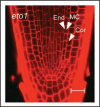Cortex proliferation: simple phenotype, complex regulatory mechanisms
- PMID: 19816127
- PMCID: PMC2688310
- DOI: 10.1111/j.1365-313X.2009.03839.x
Cortex proliferation: simple phenotype, complex regulatory mechanisms
Abstract
In plants, the cortex is a relatively undifferentiated cell type. Proliferation of cortex tissues initially appeared to be a simple process of repetitive cell division. However, our recent studies showed that in the Arabidopsis root cortex proliferation involves complex regulatory mechanisms. First, it requires the combined activity of the transcriptional regulators SHORT-ROOT (SHR) and SCARECROW (SCR), but SCR also plays a role in restricting the number of cell divisions. The two opposing activities appear to be mediated by different domains of SCR through physical interaction with distinct partners, and whether SCR behaves as an activator or repressor depends on the relative level of the two protein complexes. We confirmed previous findings that GA plays a major role in cortex proliferation, but also found distinct roles for GA signaling components in this process. We showed that ABA and ethylene also play a role in cortex proliferation, but in an unexpected manner. Finally, we identified an epigenetic component of the regulation, and our data suggested that this is likely the common basis on which various pathways converge. There is evidence that similar mechanisms to those found in Arabidopsis are employed in other plant species.
Figures


Comment on
-
Interplay between SCARECROW, GA and LIKE HETEROCHROMATIN PROTEIN 1 in ground tissue patterning in the Arabidopsis root.Plant J. 2009 Jun;58(6):1016-27. doi: 10.1111/j.1365-313X.2009.03839.x. Epub 2009 Feb 18. Plant J. 2009. PMID: 19228333 Free PMC article.
References
-
- Dolan L, Janmaat K, Willemsen V, Linstead P, Poethig S, Roberts K, Scheres B. Cellular organisation of the Arabidopsis thaliana root. Development. 1993;119:71–84. - PubMed
-
- Di Laurenzio L, Wysocka-Diller J, Malamy JE, Pysh L, Helariutta Y, Freshour G, et al. The SCARECROW gene regulates an asymmetric cell division that is essential for generating the radial organization of the Arabidopsis root. Cell. 1996;86:423–433. - PubMed
-
- Helariutta Y, Fukaki H, Wysocka-Diller J, Nakajima K, Jung J, Sena G, et al. The SHORT-ROOT gene controls radial patterning of the Arabidopsis root through radial signaling. Cell. 2000;101:555–567. - PubMed
Publication types
LinkOut - more resources
Full Text Sources
